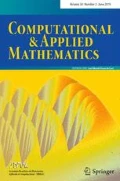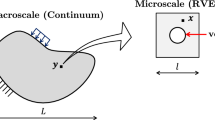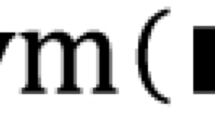Abstract
This article addresses numerical simulation of the mechanical behaviour of materials comprising heterogeneous ductile micro-structures in the presence of voids using a multi-scale approach considering plasticity processes. This kind of material has been used in several applications as structural solutions. Therefore, for safety reasons, studies about stress analysis of porous ductile materials are essential to understand their mechanical behaviour. Numerical modelling is performed in micro-structures using the concept of representative volume element (RVE) where the matrix is considered as an ideally plastic material governed by the von Mises model with isotropic hardening, while inclusions are adopted as very stiff elastic materials. Also, fracture and contact finite elements are used to model the phase debonding. Different distributions of voids and inclusions are assumed in the RVE domain to investigate their influences on the proposed analyses. We conclude, for instance, that the concentration of voids in the RVE decreases its loading capacity. On the other hand, we show in the numerical examples that the RVEs containing random distributions of voids present loading capacity improved when compared to the RVEs containing symmetric distributions of voids. Moreover, the results show that the insertion of reinforcements into porous ductile media has limited efficiency when dealing with high values of loading.








































Similar content being viewed by others
References
Babout L, Brechet Y, Maire E, Fougères R (2004) On the competition between particle fracture and particle decohesion in metal matrix composites. Acta Mater 52:4517–4525. https://doi.org/10.1016/j.actamat.2004.06.009
Borges DC, Pituba JJC (2017) Analysis of quasi-brittle materials at mesoscopic level using Homogenization model. Adv Conc Constr 5:221–240. https://doi.org/10.12989/acc.2017.5.3.221
Bourih A, Kaddouri W, Kanit T, Madani S, Imad A (2018) Effective yield surface of porous media with random overlapping identical spherical voids. J Eng Mater Trans ASME 7:103–117. https://doi.org/10.1016/j.jmrt.2017.01.002
Chu C, Needleman A (1980) Void nucleation effects in biaxially stretched sheets. J Eng Mater -T ASME 102:249–256. https://doi.org/10.1115/1.3224807
Fernandes GR, Pituba JJC, Souza Neto EA (2015) FEM/BEM formulation for multi-scale analysis of stretched plates. Eng Anal Bound Elem 54:47–59. https://doi.org/10.1016/j.enganabound.2015.01.005
Fernandes GR, Marques MJ, Vieira JF, Pituba JJC (2019) A RVE formulation by the boundary element method considering phase debonding. Eng Anal Bound Elem 104:259–276. https://doi.org/10.1016/j.enganabound.2019.03.018
Giusti SM, Blanco PJ, Souza Neto EA, Feijóo RA (2009) An assessment of the gurson yield criterion by a computational multi-scale approach. Eng Comput 26:281–301. https://doi.org/10.1108/02644400910943626
Grondin F, Dumontet H, Hamida B, Mounajed G, Boussa H (2007) Multi-scales modelling for the behaviour of damaged concrete. Cement Concr Res 37:1453–1462. https://doi.org/10.1016/j.cemconres.2007.05.012
Gurson AL (1977) Continuum theory of ductile rupture by void nucleation and growth: part I - yield criteria and flow rules for porous ductile media. J Eng Mater Trans ASME 99:2–15. https://doi.org/10.1115/1.3443401
Hao S, Brocks W (1997) The Gurson-Tvergaard-Needleman-model for rate and temperature-dependent materials with isotropic and kinematic hardening. Comput Mech 20:34–40. https://doi.org/10.1007/s004660050213
Kanouté P, Boso DP, Chaboche JL, Schrefler BA (2009) Multiscale methods for composites: a review. Arch Comput Method E 16:31–75. https://doi.org/10.1007/s11831-008-9028-8
Karamnejad A, Nguyen VP, Sluys LJ (2013) A multi-scale rate dependent crack model for quasi-brittle heterogeneous materials. Eng Fract Mech 104:96–113. https://doi.org/10.1016/j.engfracmech.2013.03.009
Koplik J, Needleman A (1988) Void growth and coalescence in porous plastic solids. Int J Solids Struct 24:835–853. https://doi.org/10.1016/0020-7683(88)90051-0
Lippitz N, Rurkowska K, Rösler J, Langer S (2014) Fouling behaviour of porous metals. Proc Mat Sci 4:299–303. https://doi.org/10.1016/j.mspro.2014.07.561
Marino M, Hudobivnik B, Wriggers P (2019) Computational homogenization of polycrystalline materials with the virtual element method. Comput Method Appl M 355:349–372. https://doi.org/10.1016/j.cma.2019.06.004
Montero-Chacón F, Marín-Montín J, Medina F (2014) Mesomechanical characterization of porosity in cementitious composites by means of a voxel-based finite element model. Comp Mater Sci 90:157–170. https://doi.org/10.1016/j.commatsci.2014.03.066
Nakajima H (2010) Fabrication, properties and applications of porous metals with directional pores. Proc Jpn Acad B-Phys 86:884–899. https://doi.org/10.2183/pjab.86.884
Nguyen VP, Stroeven M, Sluys LJ (2011) Multiscale continuous and discontinuous modeling of heterogeneous materials: a review on recent developments. J Multiscale Model 3:1–42. https://doi.org/10.1142/S1756973711000509
Nguyen VP, Lloberas-valls O, Stroeven M, Sluys LJ (2012a) Computational homogenization for multiscale crack modelling. Implementational and computational aspects. Int J Numer Methods Eng 89:192–226. https://doi.org/10.1002/nme.3237
Nguyen VP, Stroeven M, Sluys LJ (2012b) An enhanced continuous-discontinuous multiscale method for modelling mode-I failure in random heterogeneous quasi-brittle materials. Eng Fract Mech 79:78–102. https://doi.org/10.1016/j.engfracmech.2011.10.005
Oliver J, Caicedo M, Roubin E, Huespe AE, Hernandez JA (2015) Continuum approach to computational multiscale modelling of propagating fracture. Comput Method Appl M 294:384–427. https://doi.org/10.1016/j.cma.2015.05.012
Perić D, Souza Neto EA, Feijóo RA, Partovi M, Molina AC (2011) On micro-to-macro transitions for multiscale analysis of heterogeneous materials: unified variational basis and finite element implementation. Int J Numer Methods Eng 87:149–170. https://doi.org/10.1002/nme.3014
Pinea A, Benzerga AA, Pardoen T (2016) Failure of metals I; Brittle and ductile fracture. Acta Mater 107:424–483. https://doi.org/10.1016/j.actamat.2015.12.034
Pituba JJC (2015) A damage model formulation: unilateral effect and RC structures analysis. Comput Concr 15:709–733. https://doi.org/10.12989/cac.2015.15.5.709
Pituba JJC, Souza Neto EA (2015) Modeling of unilateral effect in brittle materials by a mesoscopic scale approach. Comput Concrete 15:735–758. https://doi.org/10.12989/cac.2015.15.5.735
Pituba JJC, Fernandes GR, Souza Neto EA (2016) Modelling of cohesive fracture and plasticity processes in composite microstructures. J Eng Mech 142:04016069. https://doi.org/10.1061/(ASCE)EM.1943-7889.0001123
Proença SPB, Pituba JJC (2003) A damage constitutive model accounting for induced anisotropy and bimodular elastic response. Lat Am J Solids Stru 1:101–117
Qin L, Chen Q, Yang C, Huang Y (2016) Research process on property and application of metal porous materials. J Alloy Compd 654:39–44. https://doi.org/10.1016/j.jallcom.2015.09.148
Reis FJP (2014) Multi-scale modelling and analysis of heterogeneous solids at finite strains. PhD dissertation, Faculty of Engineering, University of Porto
Rodrigues EA, Manzoli OL, Bittencourt LAG Jr, Bittencourt TN (2016) 2D mesoscale model for concrete based on the use of interface element with high aspect ratio. Int J Solids Struct 94–95:112–124. https://doi.org/10.1016/j.ijsolstr.2016.05.004
Santos WF, Pituba JJC (2017) Yield Surfaces of Material Composed of Porous and Heterogeneous Microstructures considering Phase Debonding. Lat Am J Solids Stru 14:1387–1415. https://doi.org/10.1590/1679-78253776
Santos WF, Fernandes GR, Pituba JJC (2016) Analysis of the influence of plasticity and fracture processes on the mechanical behavior of metal matrix composites microstructures. Materials 21:577–598. https://doi.org/10.1590/S1517-707620160003.0056
Souza Neto EA, Blanco PJ, Sanchez PJ, Feijóo RA (2015) An RVE-based multiscale theory of solids with micro-scale inertia and body force effects. Mech Mater 80:136–144. https://doi.org/10.1016/j.mechmat.2014.10.007
Toro S, Sánchez PJ, Blanco PJ, Souza Neto EA, Huespe AE, Feijóo RA (2016) Multiscale formulation for material failure accounting for cohesive cracks at the macro and micro scales. Int J Plasticity 76:75–110. https://doi.org/10.1016/j.ijplas.2015.07.001
Tvergaard V (1981) Influence of voids on shear band instabilities under plane strain conditions. Int J Fract 17:389–407. https://doi.org/10.1007/BF00036191
Tvergaard V (1982) Influence of void nucleation on ductile shear fracture at a free surface. J Mech Phys Solids 30:399–425. https://doi.org/10.1016/0022-5096(82)90025-4
Tvergaard V, Needleman A (1984) Analysis of the cup-cone fracture in a round tensile bar. Acta Mater 32:157–169. https://doi.org/10.1016/0001-6160(84)90213-X
Utsunomiya H, Matsumoto R (2014) Deformation processes of porous metals and metallic foams (review). Proc Mater Sci 4:245–249. https://doi.org/10.1016/j.mspro.2014.07.614
Vorel J, Šmilauer V, Bittnar Z (2012) Multiscale simulations of concrete mechanical tests. J Comput Appl Math 236:4882–4892. https://doi.org/10.1016/j.cam.2012.01.009
Yeratapally SR, Ieser PE, Hochhalter JD, Ieser W, Ruggles T (2020) A digital twin feasibility study (Part I): non-deterministic predictions of fatigue life in aluminum alloy 7075–T651 using a microstructure-based multi-scale model. Eng Fract Mech 228:106888. https://doi.org/10.1016/j.engfracmech.2020.106888
Zhou J, Gao X, Sobotka JC, Webler BA, Cockeram BV (2014) On the extension of the gurson-type porous plasticity models for prediction of ductile fracture under shear-dominated conditions. Int J Solids Struct 51:3273–3291. https://doi.org/10.1016/j.ijsolstr.2014.05.028
Acknowledgements
This work was supported by CNPq (National Council for Scientific and Technological Development) [Grant numbers 304281/2018-2, 302382/2017-8]; and FAPEG (Goiás Research Foundation) [Grant number 201710267000521].
Author information
Authors and Affiliations
Contributions
WFS: writing, methodology, data curation, and formal analysis; GAR: writing, data curation, and formal analysis; GRF: conceptualization, funding acquisition, supervision, writing, methodology, and formal analysis; JJCP: conceptualization, funding acquisition, supervision, writing, methodology, and formal analysis.
Corresponding author
Additional information
Communicated by Abimael Loula.
Publisher's Note
Springer Nature remains neutral with regard to jurisdictional claims in published maps and institutional affiliations.
Rights and permissions
About this article
Cite this article
Pituba, J.J.C., dos Santos, W.F., Ribeiro, G.A. et al. Computational homogenisation approach applied to improve mechanical properties of heterogeneous materials. Comp. Appl. Math. 40, 187 (2021). https://doi.org/10.1007/s40314-021-01580-w
Received:
Revised:
Accepted:
Published:
DOI: https://doi.org/10.1007/s40314-021-01580-w




